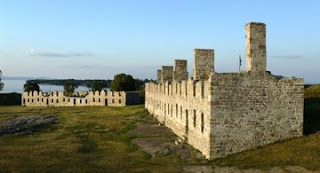 Ogdensburg, in St. Lawrence County, will play host to it’s annual Founder’s Day celebration, French and Indian War reenactment, and colonial trade fair on Saturday, July 23 10:00 AM to 5:00 PM and Sunday, July 24 10:00 AM to 3:00 PM.
Ogdensburg, in St. Lawrence County, will play host to it’s annual Founder’s Day celebration, French and Indian War reenactment, and colonial trade fair on Saturday, July 23 10:00 AM to 5:00 PM and Sunday, July 24 10:00 AM to 3:00 PM.
More than 250 years ago the roar of cannon fire echoed over the St. Lawrence River on the now peaceful stretch between Ogdensburg, New York and Prescott, Ontario. The final battle of the French and Indian War – the battle that truly led to the French losing Canada to the English – was fought here in August 1760.
Founder’s Day Weekend is the annual commemoration of Ogdensburg’s French colonial history and the Battle of the Thousand Islands. Lighthouse Point features a military re-enactment and colonial trade fair. As many as 500 participants from the U.S. and Canada, dressed in 18th-century clothes, will establish an encampment of white canvass tents.
French and English naval contingents will moor their historically accurate small boats along the shore and bivouac there. The crews will race on Saturday morning, but Saturday and Sunday afternoon the boats with bow guns and muskets in battle on the river. The skirmishing on the water leads into the land battle. Across the width of Lighthouse Point, the opposing forces and their Native allies will maneuver.
Civilian life of the colonies will also be represented as women and children, pipers, dancers, artisans, traditional tradesmen and women, and sutlers, the merchants that followed the armies, set up their shops to furnish just about anything a re-enactor, or 21st-century tourist, could want.
The re-enactment of the Battle of the Thousand Islands and the colonial trade fair are adjacent to the archaeological remains of Fort de la Presentation, built by the French in 1749. When the tide of war turned in favor of the English, the French vacated the fort in early 1759 and continued the construction of Fort Levis downriver on Ile Royal, now Chimney Island. La Presentation was a wooden stockade- Levis was a substantial fortification.
The 1760 Battle of the Thousand Islands began with the capture of the French corvette L’Outauaise by a swarm of English row galleys off abandoned Fort de la Presentation. The battle continued with the successful, weeklong siege of Fort Levis. The English pressed on to accept the capitulation of Montreal.
For more than a decade, the annual Founder’s Day Weekend has honored the shared history of Canada and the United States. Here, where the Oswegatchie River flows into the St. Lawrence, the Fort La Presentation Association plans to rebuild the historic fort as a high-quality, tourist attraction.
Admission: Adults $8- Children 7 to 12 $2- children 6 and under free.
More information is available online or by calling the St. Lawrence County Chamber of Commerce at 1-877-228-7810.
Photo courtesy Sandy Goss, Eagle Bay Media.



